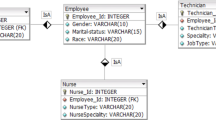Abstract
A wide range of the database systems in use today are based on the relational model. As a consequence, more information used by those systems has been stored in multi relational object types. However, most of the traditional machine learning algorithms have not been originally proposed to handle this type of data. Aiming to propose better ways of handling the relational particularities of the data, this paper proposes a new relational clustering method based on relationship and attribute information. In our method, attributes have weights associated with their importance between the object types. An empirical analysis is performed in order to evaluate the effectiveness of the proposed method, comparing with two traditional methods for relational clustering. Three relational databases were used in the experiments.
Access this chapter
Tax calculation will be finalised at checkout
Purchases are for personal use only
Preview
Unable to display preview. Download preview PDF.
Similar content being viewed by others
References
Alfred, R., Kazakov, D.: Clustering approach to generalized pattern identification based on multi-instanced objects with dara. In: ADBIS Research Communications, pp. 38–49 (2007)
Davies, D.L., Bouldin, D.W.: A cluster separation measure. IEEE Transactions on Pattern Analysis and Machine Intelligence 1(2), 224–227 (1979)
Fisher, R.: Statistical methods for research workers. The Eugenics Review 18(2), 148–150 (1926)
Gao, Y., Liu, D.Y., Sun, C.M., Liu, H.: A two-stage clustering algorithm for multi-type relational data. In: Proceedings of the 2008 Ninth ACIS International Conference on Software Engineering, Artificial Intelligence, Networking, and Parallel/Distributed Computing, pp. 376–380. IEEE Computer Society, Washington, DC (2008)
Harrington, J.L.: Relational Database Design and Implementation: Clearly Explained. Morgan Kaufmann (2009)
Hubert, L., Arabie, P.: Comparing partitions. Journal of Classification 2(1), 193–218 (1985)
Jain, A.K., Murty, M.N., Flynn, P.J.: Data clustering: A review. ACM Comput. Surv. 31(3), 264–323 (1999)
Long, B., Zhang, Z., Yu, P.S.: A probabilistic framework for relational clustering. In: Proceedings of the 13th ACM SIGKDD International Conference on Knowledge Discovery and Data Mining, pp. 470–479 (2007)
Neville, J., Adler, M., Jensen, D.: Clustering relational data using attribute and link information. In: Proceedings of the Text Mining and Link Analysis Workshop (2003)
Rousseeuw, P.: Silhouettes: a graphical aid to the interpretation and validation of cluster analysis. J. Comput. Appl. Math. 20(1), 53–65 (1987)
Seltzer, M.I.: Beyond relational databases. ACM Queue 3(3), 50–58 (2005)
Xavier-Júnior, J.C., Canuto, A., Freitas, A., Gonçalves, L., Silla-Jr., C.: A hierarchical approach to represent relational data applied to clustering tasks. In: International Joint Conference on Neural Networks, pp. 3055–3062. IEEE Press (2011)
Xavier-Junior, J.C., Signoretti, A., Canuto, A.M.P., Campos, A.M., Gonçalves, L.M.G., Fialho, S.V.: Introducing Affective Agents in Recommendation Systems Based on Relational Data Clustering. In: Hameurlain, A., Liddle, S.W., Schewe, K.-D., Zhou, X. (eds.) DEXA 2011, Part II. LNCS, vol. 6861, pp. 303–310. Springer, Heidelberg (2011)
Yin, X., Han, J., Yu, P.S.: Cross-relational clustering with user’s guidance. In: Proceedings of the Eleventh ACM SIGKDD International Conference on Knowledge Discovery in Data Mining, KDD 2005, pp. 344–353. ACM, New York (2005)
Author information
Authors and Affiliations
Editor information
Editors and Affiliations
Rights and permissions
Copyright information
© 2012 Springer-Verlag Berlin Heidelberg
About this paper
Cite this paper
Xavier-Júnior, J.C., Canuto, A.M.P., Gonçalves, L.M.G., de Oliveira, L.A.H.G. (2012). New Approach for Clustering Relational Data Based on Relationship and Attribute Information. In: Villa, A.E.P., Duch, W., Érdi, P., Masulli, F., Palm, G. (eds) Artificial Neural Networks and Machine Learning – ICANN 2012. ICANN 2012. Lecture Notes in Computer Science, vol 7553. Springer, Berlin, Heidelberg. https://doi.org/10.1007/978-3-642-33266-1_56
Download citation
DOI: https://doi.org/10.1007/978-3-642-33266-1_56
Publisher Name: Springer, Berlin, Heidelberg
Print ISBN: 978-3-642-33265-4
Online ISBN: 978-3-642-33266-1
eBook Packages: Computer ScienceComputer Science (R0)




